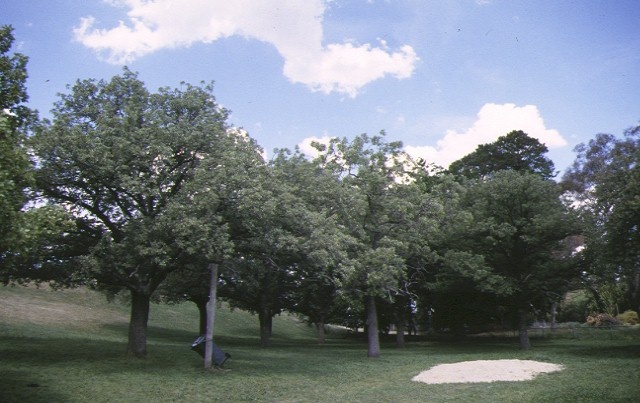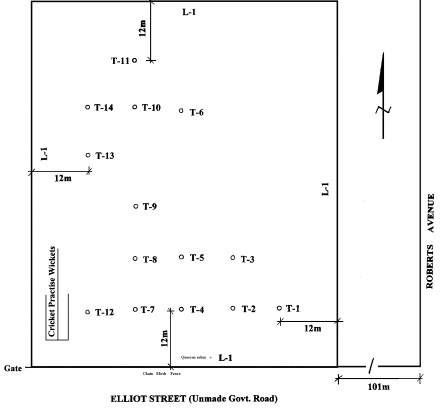CUNNACKS VALONIA OAK PLANTATION
ELLIOT STREET CASTLEMAINE, MOUNT ALEXANDER SHIRE
-
Add to tour
You must log in to do that.
-
Share
-
Shortlist place
You must log in to do that.
- Download report




Statement of Significance
The Valonia Oak (Quercus ithaburensis subsp. macrolepis) is one of the principal sources of tannin and during the nineteenth century English firms were importing thousands of tons acorn cups from Turkey. In Australia, wattle species were used for tanning but by the late nineteenth century uncontrolled bark striping had brought the population to the edge of extinction. The first importation of Valonia Oaks into Australia was by Mr George Cunnack, tanner, currier and leather merchant of Castlemaine. Acorns in two Wardian Cases were imported in June 1879, and under the direction of William Ferguson, Curator of the Macedon State Nursery, acorns were planted in a paddock adjoining Cunnack's tannery. The trees first produced acorns in about 1893 and trees were distributed to Sydney, Adelaide, Queensland, Melbourne, Geelong, Ballarat, Warrnambool, Portland, Port Fairy, Dookie and Mildura. There are only three surviving plantations in Victoria, at Castlemaine, Mooroopna Common (10 trees) and Glenaroua homestead (24 trees) near Broadford, Leongatha Labour Colony (row 6 trees) and a few isolated trees in Victoria.
The Cunnack's Valonia Oak Plantation is of historic aesthetic and scientific importance to the State of Victoria.
The Cunnack's Valonia Oak Plantation of fourteen trees is historically significant as it is the first attempt in Australia to establish an exotic replacement for local wattle species, which had been brought to the edge of extinction by uncontrolled wattle bark stripping.
Cunnack's Valonia Oak Plantation is of scientific and horticultural significance due to the plantation being the first planting in Australia. The site supplied acorns to set up other plantations in Victoria, South Australia and New South Wales. The plantation is one of only three in Victoria, and the species is uncommon in cultivation. The specimen in the north east corner produces very large acorns and is the largest and finest specimen in Victoria
The plantation of fourteen Valonia Oaks is of aesthetic significance due to their landscape value, attractive woodland setting, canopy shape and size, and are a dominant planting in the school grounds.
[11 trees died between 2011-13, 24 Valonia Oaks replanted 18 August 2016]
-
-
CUNNACKS VALONIA OAK PLANTATION - Permit Exemptions
General Exemptions:General exemptions apply to all places and objects included in the Victorian Heritage Register (VHR). General exemptions have been designed to allow everyday activities, maintenance and changes to your property, which don’t harm its cultural heritage significance, to proceed without the need to obtain approvals under the Heritage Act 2017.Places of worship: In some circumstances, you can alter a place of worship to accommodate religious practices without a permit, but you must notify the Executive Director of Heritage Victoria before you start the works or activities at least 20 business days before the works or activities are to commence.Subdivision/consolidation: Permit exemptions exist for some subdivisions and consolidations. If the subdivision or consolidation is in accordance with a planning permit granted under Part 4 of the Planning and Environment Act 1987 and the application for the planning permit was referred to the Executive Director of Heritage Victoria as a determining referral authority, a permit is not required.Specific exemptions may also apply to your registered place or object. If applicable, these are listed below. Specific exemptions are tailored to the conservation and management needs of an individual registered place or object and set out works and activities that are exempt from the requirements of a permit. Specific exemptions prevail if they conflict with general exemptions. Find out more about heritage permit exemptions here.Specific Exemptions:EXEMPTIONS FROM PERMITS:
(Classes of works or activities which may be undertaken without a permit under
Part 4 of the Heritage Act 1995)
General Conditions:
All exempted alterations are to be planned and carried out in a manner which
prevents damage to the fabric of the registered place or object.
Should it become apparent during further inspection or the carrying out of
alterations that original or previously hidden or inaccessible details of the
place or object are revealed which relate to the significance of the place or
object, then the exemption covering such alteration shall cease and the
Executive Director shall be notified as soon as possible.
If there is a conservation policy and plan approved by the Executive Director,
all works shall be in accordance with it.
Nothing in this declaration prevents the Executive Director from amending or
rescinding all or any of the permit exemptions.
Nothing in this declaration exempts owners or their agents from the
responsibility to seek relevant planning or building permits from the
responsible authority where applicable.
Landscape
Management of trees in accordance with Australian Standard, Pruning of amenity
trees AS 4373
Removal of plants listed as State Prohibited and Regionally Controlled Weeds
in the Catchment and Land Protection Act 1994
Emergency and safety works
Conservation works in accordance with The Burra Charter (ICOMOS Charter for
the conservation of cultural significance, revised 1988)
Repairs, conservation and maintenance to hard landscape elements, cricket
practise wickets, fence and gates
The process of gardening and maintenance to care for the trees and park
landscape
-
-
-
-
-
FLOUR MILL
 Victorian Heritage Register H0395
Victorian Heritage Register H0395 -
RESIDENCE
 Victorian Heritage Register H0737
Victorian Heritage Register H0737 -
RESIDENCE
 Victorian Heritage Register H0591
Victorian Heritage Register H0591
-
"1890"
 Yarra City
Yarra City -
'BRAESIDE'
 Boroondara City
Boroondara City -
'ELAINE'
 Boroondara City
Boroondara City
-
-












